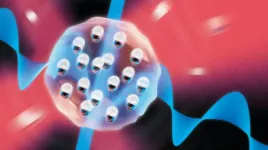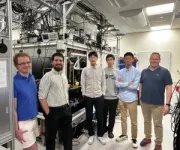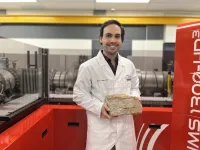(Press-News.org) There’s a hot new BEC in town that has nothing to do with bacon, egg, and cheese. You won’t find it at your local bodega, but in the coldest place in New York: the lab of Columbia physicist Sebastian Will, whose experimental group specializes in pushing atoms and molecules to temperatures just fractions of a degree above absolute zero.
Writing in Nature, the Will lab, supported by theoretical collaborator Tijs Karman at Radboud University in the Netherlands, has successfully created a unique quantum state of matter called a Bose-Einstein Condensate (BEC) out of molecules.
Their BEC, cooled to just five nanoKelvin, or about -459.66 °F, and stable for a strikingly long two seconds, is made from sodium-cesium molecules. Like water molecules, these molecules are polar, meaning they carry both a positive and a negative charge. The imbalanced distribution of electric charge facilitates the long-range interactions that make for the most interesting physics, noted Will.
Research the Will lab is excited to pursue with their molecular BECs includes exploring a number of different quantum phenomena, including new types of superfluidity, a state of matter that flows without experiencing any friction. They also hope to turn their BECs into simulators that can recreate the enigmatic quantum properties of more complex materials, like solid crystals.
“Molecular Bose-Einstein condensates open up whole new areas of research, from understanding truly fundamental physics to advancing powerful quantum simulations,” he said. “This is an exciting achievement, but it’s really just the beginning.”
It’s a dream come true for the Will lab and one that’s been decades in the making for the larger ultracold research community.
To Go Colder, Add Microwaves
Microwaves are a form of electromagnetic radiation with a long history at Columbia. In the 1930s, physicist Isidor Isaac Rabi, who would go on to the Nobel Prize in Physics, did pioneering work on microwaves that led to the development of airborne radar systems. “Rabi was one of the first to control the quantum states of molecules and was a pioneer of microwave research,” said Will. “Our work follows in that 90-year-long tradition.”
While you may be familiar with the role of microwaves in heating up your food, it turns out they can also facilitate cooling. Individual molecules have a tendency to bump into each other and will, as a result, form bigger complexes that disappear from the samples. Microwaves can create small shields around each molecule that prevent them from colliding, an idea proposed by Karman, their collaborator in the Netherlands. With the molecules shielded against lossy collisions, only the hottest ones can be preferentially removed from the sample—the same physics principle that cools your cup of coffee when you blow along the top of it, explained author Niccolò Bigagli. Those molecules that remain will be cooler, and the overall temperature of the sample will drop.
The team came close to creating molecular BEC last fall in work published in Nature Physics that introduced the microwave shielding method. But another experimental twist was necessary. When they added a second microwave field, cooling became even more efficient and sodium-cesium finally crossed the BEC threshold—a goal the Will lab had harbored since it opened at Columbia in 2018.
“This was fantastic closure for me,” said Bigagli, who graduated with his PhD in physics this spring and was a founding lab member. “We went from not having a lab set up yet to these fantastic results.”
In addition to reducing collisions, the second microwave field can also manipulate the molecules’ orientation. That in turn is a means to control how they interact, which the lab is currently exploring. “By controlling these dipolar interactions, we hope to create new quantum states and phases of matter,” said co-author and Columbia postdoc Ian Stevenson.
A New World for Quantum Physics Opens
Ye, a pioneer of ultracold science based in Boulder, considers the results a beautiful piece of science. “The work will have important impacts on a number of scientific fields, including the study of quantum chemistry and exploration of strongly correlated quantum materials,” he commented. “Will’s experiment features precise control of molecular interactions to steer the system toward a desired outcome—a marvelous achievement in quantum control technology.”
The Columbia team, meanwhile, is excited to have a theoretical description of interactions between molecules that have been validated experimentally. “We really have a good idea of the interactions in this system, which is also critical for the next steps, like exploring dipolar many-body physics,” said Karman. “We’ve come up with schemes to control interactions, tested these in theory, and implemented them in the experiment. It's been really an amazing experience to see these ideas for microwave ‘shielding’ being realized in the lab.”
There are dozens of theoretical predictions that can now be tested experimentally with the molecular BECs, which co-first author and PhD student Siwei Zhang noted, are quite stable. Most ultracold experiments take place within a second—some as short as a few milliseconds—but the lab’s molecular BECs last upwards of two seconds. “That will really let us investigate open questions in quantum physics,” he said.
One idea is to create artificial crystals with the BECs trapped in an optical lattice made from lasers. This would enable powerful quantum simulations that mimic the interactions in natural crystals, noted Will, which is a focus area of condensed matter physics. Quantum simulators are routinely made with atoms, but atoms have short-range interactions—they practically have to be on top of one another—which limits how well they can model more complicated materials. “The molecular BEC will introduce more flavor,” said Will.
That includes dimensionality, said co-first author and PhD student Weijun Yuan. “We would like to use the BECs in a 2D system. When you go from three dimensions to two, you can always expect new physics to emerge,” he said. 2D materials are a major area of research at Columbia; having a model system made of molecular BECs could help Will and his condensed matter colleagues explore quantum phenomena including superconductivity, superfluidity, and more.
"It seems like a whole new world of possibilities is opening up," Will said.
END
The coldest lab in New York has a new quantum offering
Columbia physicists have taken molecules to a new ultracold limit and created a Bose-Einstein condensate—a state of matter where quantum mechanics reigns.
2024-06-03
ELSE PRESS RELEASES FROM THIS DATE:
Altered carbon points toward sustainable manufacturing
2024-06-03
By Shawn Ballard
The recent spike in food prices isn’t just bad news for your grocery bill. It also impacts the sugars used in biomanufacturing, which, by the way, isn’t quite as green as scientists and climate advocates expected. Surging prices and increasing urgency for genuinely sustainable manufacturing has pushed researchers to explore alternative feedstocks.
Feng Jiao, the Elvera and William R. Stuckenberg Professor in in the McKelvey School of Engineering at Washington University in St. Louis, developed a two-step process to convert carbon dioxide ...
Telemedicine may increase endocrinology care access for under-resourced patients with diabetes and heart disease
2024-06-03
BOSTON—Widespread availability of telemedicine during the pandemic led to more equitable access to endocrinology care for patients with type 2 diabetes and heart disease, according to a study being presented Monday at ENDO 2024, the Endocrine Society’s annual meeting in Boston, Mass.
Patients who benefited included those living in rural areas and in neighborhoods with lower socioeconomic status, according to the study.
While most adults with type 2 diabetes receive care in the primary care setting, adults who have both type 2 diabetes and cardiovascular disease ...
Exploration of enzyme-polymer interactions is a crucial first step toward the development of next-gen degradable wound coverings
2024-06-03
Imagine you’re deep in the backcountry on a hiking trip, and you fall and rip a deep gash in your lower leg. You’re a two-day walk away from proper treatment. After you stop the bleeding, your concern becomes keeping the wound clean.
Now, imagine you had just the thing in your first aid kit—a spray-on bandage embedded with a mild painkiller and a disinfectant. A bandage meant to deliver relief, and degrade within 48 hours, giving you time to make it to the hospital.
That’s one reality that Whitney Blocher McTigue, an assistant professor ...
Pudukotai Dinakarrao receives funding for continuous and lightweight authentication for wearable and portable embedded systems
2024-06-03
Sai Manoj Pudukotai Dinakarrao, Assistant Professor, Electrical and Computer Engineering, received funding for the project: “CLAWS: Continuous and Lightweight Authentication for Wearable and Portable Embedded Systems.”
“The target of this funding is to accelerate the transition of technology,” Pudukotai Dinakarrao said.
Using this proposed authentication technique, Pudukotai Dinakarrao will collect the gait signal of a user continually using a lightweight always-on sensing methodology. The collected gait signal will be analyzed through resource-aware dynamic early-exit neural networks (EENets) for authentication.
The proposed technique ...
Most surface ozone contributing to premature mortality in European countries is imported
2024-06-03
Exposure to current levels of ground-level ozone (O3) in Europe is one of the main causes of premature mortality due to air pollution, especially in summer. A study led both by the Barcelona Institute for Global Health (ISGlobal), a centre supported by the "la Caixa" Foundation, in collaboration with the French National Institute of Health and Medical Research (Inserm), and the Barcelona Supercomputing Center - Centro Nacional de Supercomputación (BSC-CNS), has quantified for the first ...
The integration of clinical trials with the practice of medicine
2024-06-03
About The Study: This article discusses the need for better integration of clinical trials and health care delivery enterprises.
Corresponding Author: To contact the corresponding author, Derek C. Angus, M.D., M.P.H., email angusdc@pitt.edu.
To access the embargoed study: Visit our For The Media website at this link https://media.jamanetwork.com/
(doi:10.1001/jama.2024.4088)
Editor’s Note: Please see the article for additional information, including other authors, author contributions and affiliations, conflict ...
Fresh findings: Earliest evidence of life-bringing freshwater on Earth
2024-06-03
New Curtin-led research has found evidence that fresh water on Earth, which is essential for life, appeared about four billion years ago - five hundred million years earlier than previously thought.
Lead author Dr Hamed Gamaleldien, Adjunct Research Fellow in Curtin’s School of Earth and Planetary Sciences and an Assistant Professor at Khalifa University, UAE, said by analysing ancient crystals from the Jack Hills in Western Australia’s Mid West region, researchers have pushed back the timeline ...
Study finds people of color disproportionately dropped from Medicaid
2024-06-03
The COVID-19 pandemic dramatically improved health insurance coverage for millions of Americans who were automatically covered by Medicaid due to the national public health emergency.
With the end of the emergency in April 2023, about 10 million people lost coverage as states began redetermining eligibility. However, an estimated three-quarters of disenrollments occurred not because states decided they were ineligible, but rather due to procedural reasons. These process-related issues could include enrollees not receiving ...
Weight indices, cognition, and mental health from childhood to early adolescence
2024-06-03
About The Study: Lower cognitive performance and greater psychopathology at baseline were associated with increased weight gain as children entered adolescence, and higher baseline body mass index was associated with more depressive symptoms over time. These longitudinal findings highlight the importance of cognitive and mental health to children’s healthy weight development and suggest that clinicians should monitor children with overweight or obesity for increased depression problems.
Corresponding Author: To contact the corresponding author, Tamara Hershey, Ph.D., email tammy@wustl.edu.
To access the embargoed study: Visit our For The Media ...
Clinical outcomes after admission of patients with COVID-19 to skilled nursing facilities
2024-06-03
About The Study: The results of this cohort study suggest that admission of COVID-19–positive patients into skilled nursing facilities early in the pandemic was associated with preventable COVID-19 cases and mortality among residents, particularly in facilities with potential staff and personal protective equipment shortages. The findings speak to the importance of equipping skilled nursing facilities to adhere to infection-control best practices as they continue to face COVID-19 strains and other respiratory diseases.
Corresponding Author: To contact ...
LAST 30 PRESS RELEASES:
Eye for trouble: Automated counting for chromosome issues under the microscope
The vast majority of US rivers lack any protections from human activities, new research finds
Ultrasound-responsive in situ antigen "nanocatchers" open a new paradigm for personalized tumor immunotherapy
Environmental “superbugs” in our rivers and soils: new one health review warns of growing antimicrobial resistance crisis
Triple threat in greenhouse farming: how heavy metals, microplastics, and antibiotic resistance genes unite to challenge sustainable food production
Earthworms turn manure into a powerful tool against antibiotic resistance
AI turns water into an early warning network for hidden biological pollutants
Hidden hotspots on “green” plastics: biodegradable and conventional plastics shape very different antibiotic resistance risks in river microbiomes
Engineered biochar enzyme system clears toxic phenolic acids and restores pepper seed germination in continuous cropping soils
Retail therapy fail? Online shopping linked to stress, says study
How well-meaning allies can increase stress for marginalized people
Commercially viable biomanufacturing: designer yeast turns sugar into lucrative chemical 3-HP
Control valve discovered in gut’s plumbing system
George Mason University leads phase 2 clinical trial for pill to help maintain weight loss after GLP-1s
Hop to it: research from Shedd Aquarium tracks conch movement to set new conservation guidance
Weight loss drugs and bariatric surgery improve the body’s fat ‘balance:’ study
The Age of Fishes began with mass death
TB harnesses part of immune defense system to cause infection
Important new source of oxidation in the atmosphere found
A tug-of-war explains a decades-old question about how bacteria swim
Strengthened immune defense against cancer
Engineering the development of the pancreas
The Journal of Nuclear Medicine ahead-of-print tip sheet: Jan. 9, 2026
Mount Sinai researchers help create largest immune cell atlas of bone marrow in multiple myeloma patients
Why it is so hard to get started on an unpleasant task: Scientists identify a “motivation brake”
Body composition changes after bariatric surgery or treatment with GLP-1 receptor agonists
Targeted regulation of abortion providers laws and pregnancies conceived through fertility treatment
Press registration is now open for the 2026 ACMG Annual Clinical Genetics Meeting
Understanding sex-based differences and the role of bone morphogenetic protein signaling in Alzheimer’s disease
Breakthrough in thin-film electrolytes pushes solid oxide fuel cells forward
[Press-News.org] The coldest lab in New York has a new quantum offeringColumbia physicists have taken molecules to a new ultracold limit and created a Bose-Einstein condensate—a state of matter where quantum mechanics reigns.



